生物专业英语第六课-5
- 格式:pptx
- 大小:54.81 KB
- 文档页数:8
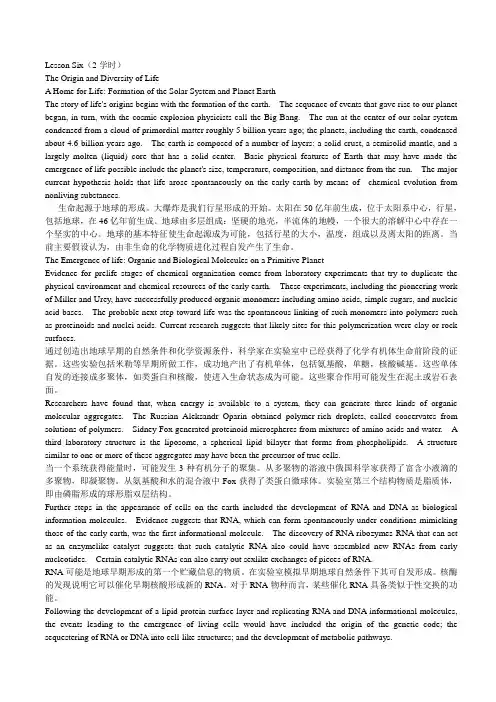
Lesson Six(2学时)The Origin and Diversity of LifeA Home for Life: Formation of the Solar System and Planet EarthThe story of life's origins begins with the formation of the earth. The sequence of events that gave rise to our planet began, in turn, with the cosmic explosion physicists call the Big Bang. The sun at the center of our solar system condensed from a cloud of primordial matter roughly 5 billion years ago; the planets, including the earth, condensed about 4.6 billion years ago. The earth is composed of a number of layers: a solid crust, a semisolid mantle, and a largely molten (liquid) core that has a solid center. Basic physical features of Earth that may have made the emergence of life possible include the planet's size, temperature, composition, and distance from the sun. The major current hypothesis holds that life arose spontaneously on the early earth by means of chemical evolution from nonliving substances.生命起源于地球的形成。
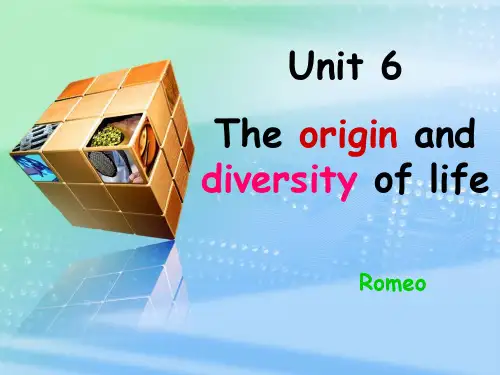
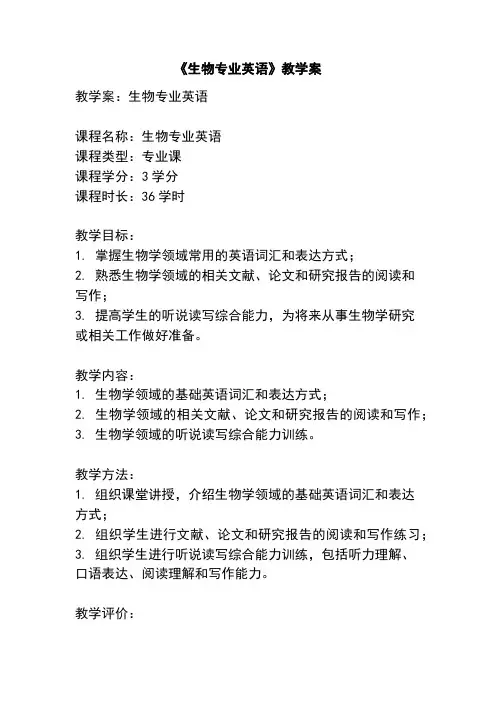
《生物专业英语》教学案教学案:生物专业英语课程名称:生物专业英语课程类型:专业课课程学分:3学分课程时长:36学时教学目标:1. 掌握生物学领域常用的英语词汇和表达方式;2. 熟悉生物学领域的相关文献、论文和研究报告的阅读和写作;3. 提高学生的听说读写综合能力,为将来从事生物学研究或相关工作做好准备。
教学内容:1. 生物学领域的基础英语词汇和表达方式;2. 生物学领域的相关文献、论文和研究报告的阅读和写作;3. 生物学领域的听说读写综合能力训练。
教学方法:1. 组织课堂讲授,介绍生物学领域的基础英语词汇和表达方式;2. 组织学生进行文献、论文和研究报告的阅读和写作练习;3. 组织学生进行听说读写综合能力训练,包括听力理解、口语表达、阅读理解和写作能力。
教学评价:1. 平时成绩占总评成绩的50%,包括课堂表现、作业完成情况等;2. 期末考试占总评成绩的50%,包括听力、口语、阅读和写作等方面的考核。
教学安排:第一周:介绍课程内容和教学目标,进行生物学领域的基础英语词汇和表达方式的讲解。
第二周:组织学生进行生物学领域文献、论文和研究报告的阅读练习,要求学生掌握阅读技巧和理解能力。
第三周:进行生物学领域听力训练,包括听取生物学相关讲座、演讲和讨论,并进行口语表达练习。
第四周:组织学生进行生物学领域的写作练习,包括摘要、实验报告和论文等的写作。
第五周:进行生物学领域的阅读理解练习,包括阅读和理解生物学相关文献和研究报告。
第六周:进行生物学领域的综合能力训练,包括听说读写的综合练习和模拟考试。
第七周:进行期末考试,包括听力、口语、阅读和写作等方面的考核。
第八周:总结课程内容和教学效果,进行学生评价和教师评价。
教学资源:1. 生物学领域的教材和参考书籍;2. 生物学领域的相关文献、论文和研究报告;3. 生物学领域的讲座、演讲和讨论录音或视频资料;4. 生物学领域的写作指南和范例;5. 听力、口语、阅读和写作练习题目和模拟试卷。
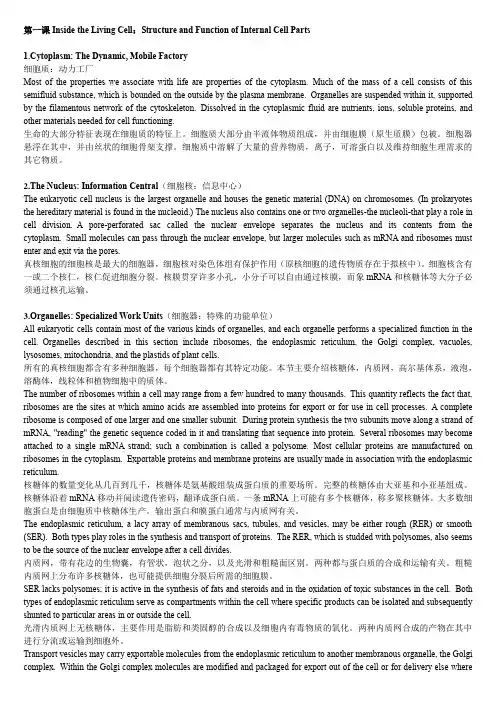
第一课Inside the Living Cell:Structure and Function of Internal Cell Parts1.Cytoplasm: The Dynamic, Mobile Factory细胞质:动力工厂Most of the properties we associate with life are properties of the cytoplasm. Much of the mass of a cell consists of this semifluid substance, which is bounded on the outside by the plasma membrane. Organelles are suspended within it, supported by the filamentous network of the cytoskeleton. Dissolved in the cytoplasmic fluid are nutrients, ions, soluble proteins, and other materials needed for cell functioning.生命的大部分特征表现在细胞质的特征上。
细胞质大部分由半流体物质组成,并由细胞膜(原生质膜)包被。
细胞器悬浮在其中,并由丝状的细胞骨架支撑。
细胞质中溶解了大量的营养物质,离子,可溶蛋白以及维持细胞生理需求的其它物质。
2.The Nucleus: Information Central(细胞核:信息中心)The eukaryotic cell nucleus is the largest organelle and houses the genetic material (DNA) on chromosomes. (In prokaryotes the hereditary material is found in the nucleoid.) The nucleus also contains one or two organelles-the nucleoli-that play a role in cell division. A pore-perforated sac called the nuclear envelope separates the nucleus and its contents from the cytoplasm. Small molecules can pass through the nuclear envelope, but larger molecules such as mRNA and ribosomes must enter and exit via the pores.真核细胞的细胞核是最大的细胞器,细胞核对染色体组有保护作用(原核细胞的遗传物质存在于拟核中)。
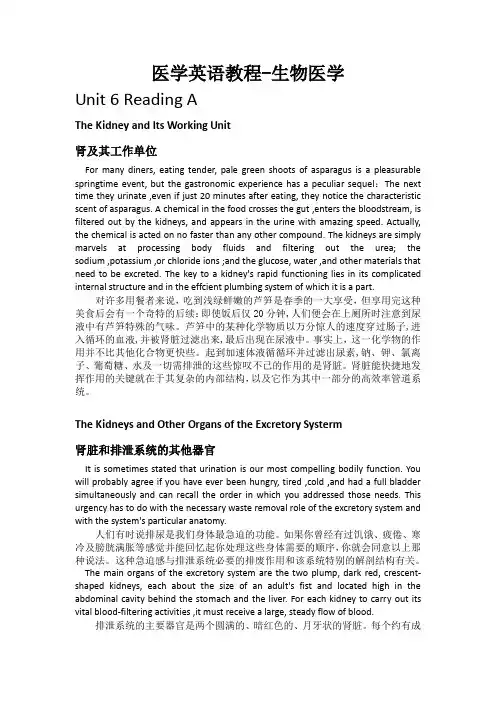
医学英语教程-生物医学Unit 6 Reading AThe Kidney and Its Working Unit肾及其工作单位For many diners, eating tender, pale green shoots of asparagus is a pleasurable springtime event, but the gastronomic experience has a peculiar sequel:The next time they urinate ,even if just 20 minutes after eating, they notice the characteristic scent of asparagus. A chemical in the food crosses the gut ,enters the bloodstream, is filtered out by the kidneys, and appears in the urine with amazing speed. Actually, the chemical is acted on no faster than any other compound. The kidneys are simply marvels at processing body fluids and filtering out the urea; the sodium ,potassium ,or chloride ions ;and the glucose, water ,and other materials that need to be excreted. The key to a kidney's rapid functioning lies in its complicated internal structure and in the effcient plumbing system of which it is a part.对许多用餐者来说,吃到浅绿鲜嫩的芦笋是春季的一大享受,但享用完这种美食后会有一个奇特的后续:即使饭后仅20分钟,人们便会在上厕所时注意到尿液中有芦笋特殊的气味。
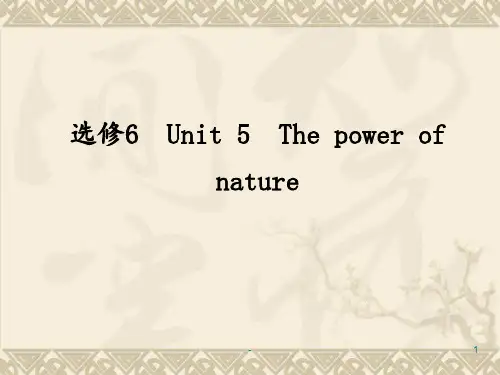
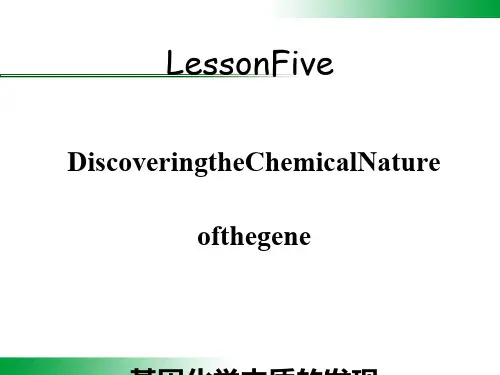
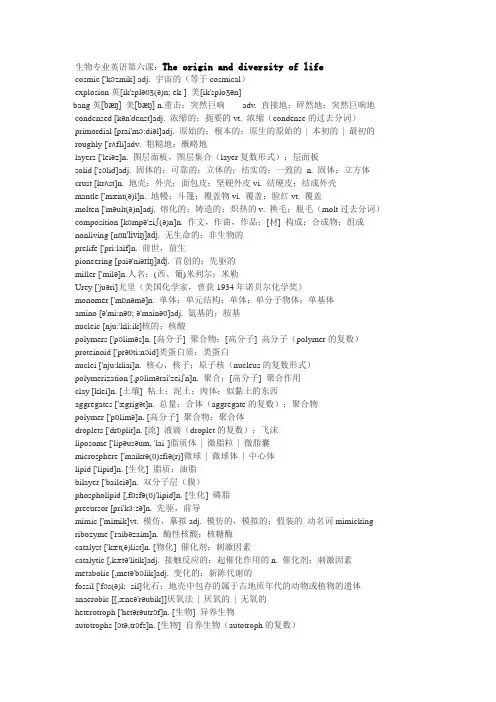
生物专业英语第六课:The origin and diversity of lifecosmic['kɔzmik]adj. 宇宙的(等于cosmical)explosion英[ik'spləʊʒ(ə)n; ek-] 美[ik'sploʒən]bang英[bæŋ]美[bæŋ] n.重击;突然巨响adv. 直接地;砰然地;突然巨响地condensed [kən'denst]adj. 浓缩的;扼要的vt. 浓缩(condense的过去分词)primordial [prai'mɔ:diəl]adj. 原始的;根本的;原生的原始的| 本初的| 最初的roughly ['rʌfli]adv. 粗糙地;概略地layers ['leiəz]n. 图层面板,图层集合(layer复数形式);层面板solid ['sɔlid]adj. 固体的;可靠的;立体的;结实的;一致的n. 固体;立方体crust [krʌst]n. 地壳;外壳;面包皮;坚硬外皮vi. 结硬皮;结成外壳mantle ['mænt(ə)l]n. 地幔;斗篷;覆盖物vi. 覆盖;脸红vt. 覆盖molten ['məult(ə)n]adj. 熔化的;铸造的;炽热的v. 换毛;脱毛(molt过去分词)composition [kɔmpə'ziʃ(ə)n]n. 作文,作曲,作品;[材] 构成;合成物;组成nonliving [nɒn'liviŋ]adj. 无生命的;非生物的prelife ['pri:laif]n. 前世,前生pioneering [paiə'niəriŋ]adj. 首创的;先驱的miller ['milə]n.人名;(西、葡)米列尔;米勒Urey ['juəri]尤里(美国化学家,曾获1934年诺贝尔化学奖)monomer ['mɒnəmə]n. 单体;单元结构;单体;单分子物体;单基体amino [ə'mi:nəʊ; ə'mainəʊ]adj. 氨基的;胺基nucleic [nju:'kli:ik]核的;核酸polymers ['pɔliməs]n. [高分子] 聚合物;[高分子] 高分子(polymer的复数)proteinoid ['prəʊti:nɔid]类蛋白质;类蛋白nuclei ['nju:kliai]n. 核心,核子;原子核(nucleus的复数形式)polymerization [,pɔlimərai'zeiʃn]n. 聚合;[高分子] 聚合作用clay [klei]n. [土壤] 粘土;泥土;肉体;似黏土的东西aggregates ['ægrigət]n. 总量;合体(aggregate的复数);聚合物polymer ['pɒlimə]n. [高分子] 聚合物;聚合体droplets ['drɒplit]n. [流] 液滴(droplet的复数);飞沫liposome ['lipəusəum, 'lai-]脂质体| 微脂粒| 微脂囊microsphere ['maikrə(ʊ)sfiə(r)]微球| 微球体| 中心体lipid ['lipid]n. [生化] 脂质;油脂bilayer ['baileiə]n. 双分子层(膜)phospholipid [,fɒsfə(ʊ)'lipid]n. [生化] 磷脂precursor [pri'kɜ:sə]n. 先驱,前导mimic ['mimik]vt. 模仿,摹拟adj. 模仿的,模拟的;假装的动名词mimicking ribozyme ['raibəzaim]n. 酶性核酸;核糖酶catalyst ['kæt(ə)list]n. [物化] 催化剂;刺激因素catalytic [,kætə'litik]adj. 接触反应的;起催化作用的n. 催化剂;刺激因素metabolic [,metə'bɔlik]adj. 变化的;新陈代谢的fossil ['fɔs(ə)l; -sil]化石;地壳中包存的属于古地质年代的动物或植物的遗体anaerobic [[,æneə'rəubik]]厌氧法| 厌氧的| 无氧的heterotroph ['hetərəutrɔf]n. [生物] 异养生物autotrophs [ɔtə,trɔfs]n. [生物] 自养生物(autotroph的复数)ozone ['əuzəun]n. [化学] 臭氧;新鲜的空气penetration [peni'treiʃ(ə)n]n. 渗透;突破;侵入;洞察力ultraviolet [ʌltrə'vaiələt]adj. 紫外的;紫外线的n. 紫外线辐射,紫外光shallow ['ʃæləʊ]n. [地理] 浅滩adj. 浅的;肤浅的aerobic [[eə'rəʊbik]]有氧的;需氧的;好气inner [inə]adj. 内部的;内心的;精神的partially ['pɑ:ʃ(ə)li]adv. 部分地;局部地segment ['segm(ə)nt]n. 段;部分continental [kɒnti'nent(ə)l]adj. 大陆的;大陆性的drift [drift]n. 漂流,漂移;趋势;漂流物sculpt [skʌlpt]vt. vi. 造型;雕刻accompany [ə'kʌmpəni]vt. 陪伴,伴随;伴奏过去式accompanied occasional [ə'keiʒ(ə)n(ə)l]adj. 偶然的;临时的;特殊场合的extinction [ik'stiŋ(k)ʃ(ə)n; ek-]n. 消失;消灭;废止;灭绝glaciation ['glesi'eʃən]冰川作用;冰蚀现象;冻结成冰orbit ['ɔ:bit]n. 轨道;vt. 绕轨道而行taxonomy [tæk'sɒnəmi]n. 分类学;分类法binomial [bai'nəʊmiəl]n. [数] 二项式;二种名称adj. 二项式的;二种名称的nomenclature [nə(ʊ)'meŋklətʃə; 'nəʊmən,kleitʃə]n. 命名法;术语Linnaeus [li'ni(:)əs]n. 林奈(瑞典博物学家,建立了植物等级)categorize ['kætəgəraiz]vt. 分类genus ['dʒi:nəs; 'dʒenəs]n. 类,种;[生物] 属phylum ['failəm]n. 门(分类);动物门kingdom ['kiŋdəm]n. 王国;界(分类);领域division [di'viʒ(ə)n]n. [数] 除法;部门;分割;师(军队);赛区subfield ['sʌbfi:ld]n. [数] 子域;分区anatomy [ə'nætəmi]n. 解剖;解剖学;剖析;骨骼comparative [kəm'pærətiv]adj. 比较的;相当的define [di'fain]vt. 定义;使明确;规定taxon ['tæksɒn]n. [生物] 分类单元;分类学复数taxamorphological [,mɔ:fə'lɒdʒikəl]adj. 形态学的criterion [krai'tiəriən]n. (批评判断的)标准;准则;规范;准据clade [kleid]n. 分化枝;进化枝ancestor ['ænsestə]n. 始祖,祖先;被继承人phylogenetic [,failədʒi'netik]adj. [生物] 系统发生的;动植物种类史的graphic ['græfik]adj. 形象的;图表的;绘画似的;图像representation [,reprizen'teiʃ(ə)n]n. 代表;表现;表示法;陈述graphic representation 图示法| 图形表示法kingdoms monera [məu'ni:rə]原核生物界protista ['prəutistə]n. 原生生物;真核原生生物界plantae ['plæn,ti:]n. 植物界animalia [,æni'meiliə]n. 动物类;动物界organizational [,ɔ:ɡənai'zeiʃənl]adj. 组织的;编制的。

生物专业英语课后练习题含答案1. Multiple Choice1.Which of the following is the most important considerationwhen designing a polymerase chn reaction (PCR)?A. The length of the primerB. The temperature of the PCRC.The amount of DNA in the sample D. The thermal stability of the DNA polymeraseAnswer: D2.Which of the following describes the function of arestriction enzyme in molecular biology?A. Restriction enzymes are used to replicate DNA.B.Restriction enzymes are used to sequence DNA. C. Restrictionenzymes are used to cut DNA at specific sites. D. Restrictionenzymes are used to amplify DNA.Answer: C3.The gel electrophoresis separates DNA fragments according towhich of following parameters?A. SequenceB. SizeC. ConcentrationD. ChargeAnswer: B4.Which of the following is not a component of a typicalprokaryotic cell?A. NucleusB. Cell wallC. RibosomeD. PlasmidAnswer: A5.Which of the following is responsible for the majority ofoxygen production on Earth?A. FungiB. AlgaeC. ProtozoaD. BacteriaAnswer: B2. Short Answer1.What is the difference between genotype and phenotype?Genotype refers to the set of genes an organism carries, while phenotype refers to the observable trts that result from the interaction between the organism’s genes and its environmen t.2.Describe the process of translation.Translation is the process by which the information encoded in mRNA is used to synthesize a protein. It occurs on ribosomes, which contn two subunits (the small subunit and the large subunit).The process begins with the small subunit binding to the mRNAmolecule; this initiates the process of recognition of the start codon (AUG). Once the start codon is identified, the ribosome will recruit the first tRNA (transfer RNA) molecule, which carries an amino acid. The amino acid is then added to the growing peptide chn as the ribosome moves along the mRNA molecule, one codon at a time. This continues until a stop codon is reached, at which point the ribosome releases the newly synthesized protein, and the mRNA molecule is degraded.3.What is the difference between prokaryotic and eukaryoticcells?Prokaryotic cells are simpler in structure than eukaryotic cells and do not have a nucleus or membrane-bound organelles. They are typically much smaller than eukaryotic cells. Eukaryotic cells, on the other hand, have a nucleus and many membrane-boundorganelles (such as mitochondria, chloroplasts, and theendoplasmic reticulum). They are generally larger and more complex than prokaryotic cells.3. True or False1.Bacteria are always harmful to humans.False2.The most diverse group of organisms on Earth is arthropods. True3.The Calvin cycle is the process by which photosynthesisoccurs.True4.Fungi are eukaryotic organisms that are primarilydecomposers.True5.RNA splicing removes introns from the primary RNA transcript,leaving only exons.True4. MatchingMatch the following terms with their correct definition or function:1.EnzymeC. Protein molecule that acts as a catalyst in a biochemicalreaction2.GlycolysisD. The process by which glucose is broken down into pyruvate3.MitochondriaA. Organelle responsible for cell respiration4.NucleusB. Organelle responsible for the storage and transmission ofgenetic informationAnswer:1.C2.D3.A4.BConclusionThis set of practice questions is designed to test your understanding of some of the key concepts in biology. By exploringtopics like genetics, cell structure, and molecular biology, you can gn a deeper appreciation for the complexity and diversity of life on Earth.By engaging with these questions and testing your knowledge, you can become a more confident and capable biologist.。
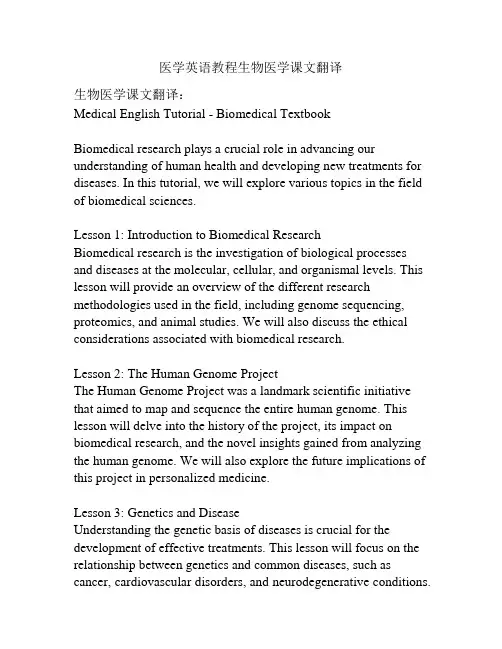
医学英语教程生物医学课文翻译生物医学课文翻译:Medical English Tutorial - Biomedical TextbookBiomedical research plays a crucial role in advancing our understanding of human health and developing new treatments for diseases. In this tutorial, we will explore various topics in the field of biomedical sciences.Lesson 1: Introduction to Biomedical ResearchBiomedical research is the investigation of biological processes and diseases at the molecular, cellular, and organismal levels. This lesson will provide an overview of the different research methodologies used in the field, including genome sequencing, proteomics, and animal studies. We will also discuss the ethical considerations associated with biomedical research.Lesson 2: The Human Genome ProjectThe Human Genome Project was a landmark scientific initiative that aimed to map and sequence the entire human genome. This lesson will delve into the history of the project, its impact on biomedical research, and the novel insights gained from analyzing the human genome. We will also explore the future implications of this project in personalized medicine.Lesson 3: Genetics and DiseaseUnderstanding the genetic basis of diseases is crucial for the development of effective treatments. This lesson will focus on the relationship between genetics and common diseases, such as cancer, cardiovascular disorders, and neurodegenerative conditions.We will also discuss the advancements in genetic testing and the potential of gene therapy.Lesson 4: Stem Cells and Regenerative MedicineStem cells have the unique ability to differentiate into various cell types, making them valuable tools in regenerative medicine. This lesson will explore the different types of stem cells, their therapeutic potential, and the current challenges in their clinical application. We will also discuss recent breakthroughs in tissue engineering and organ transplantation.Lesson 5: Drug Discovery and DevelopmentDeveloping new drugs is a complex and rigorous process. In this lesson, we will explore the steps involved in drug discovery, from target identification to preclinical and clinical trials. We will also discuss the role of animal models in drug testing and the importance of drug safety and efficacy.Lesson 6: Biomedical ImagingImaging techniques play a vital role in diagnosing diseases and monitoring treatment efficacy. This lesson will provide an overview of various imaging modalities used in biomedical research, such as X-ray, MRI, and PET. We will also discuss the advancements in imaging technology and their application in precision medicine.Lesson 7: Biomedical EthicsEthical considerations are essential in biomedical research to ensure the welfare of human and animal subjects. This lesson will discuss the ethical principles and guidelines governing biomedicalresearch. We will also explore the ethical dilemmas associated with emerging technologies, such as gene editing and artificial intelligence in healthcare.By the end of this tutorial, you will have a comprehensive understanding of key concepts and advancements in the field of biomedical sciences. This knowledge will enable you to actively engage in discussions and contribute to the ever-evolving field of medical research.。
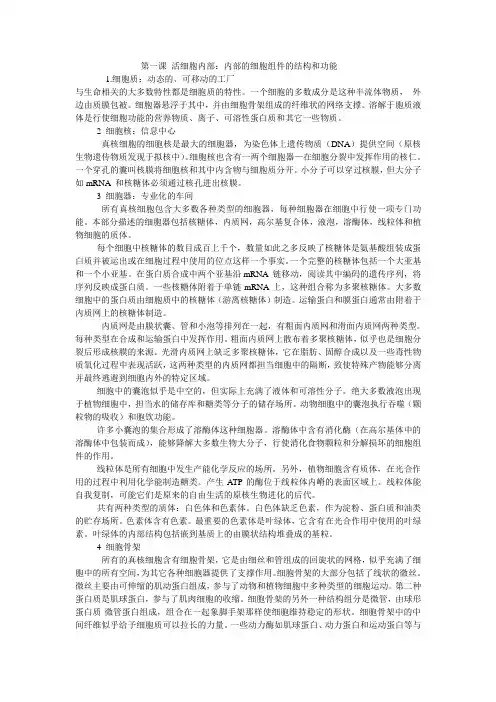
第一课活细胞内部:内部的细胞组件的结构和功能1.细胞质:动态的、可移动的工厂与生命相关的大多数特性都是细胞质的特性。
一个细胞的多数成分是这种半流体物质,外边由质膜包被。
细胞器悬浮于其中,并由细胞骨架组成的纤维状的网络支撑。
溶解于胞质液体是行使细胞功能的营养物质、离子、可溶性蛋白质和其它一些物质。
2 细胞核:信息中心真核细胞的细胞核是最大的细胞器,为染色体上遗传物质(DNA)提供空间(原核生物遗传物质发现于拟核中)。
细胞核也含有一两个细胞器—在细胞分裂中发挥作用的核仁。
一个穿孔的囊叫核膜将细胞核和其中内含物与细胞质分开。
小分子可以穿过核膜,但大分子如mRNA 和核糖体必须通过核孔进出核膜。
3 细胞器:专业化的车间所有真核细胞包含大多数各种类型的细胞器,每种细胞器在细胞中行使一项专门功能。
本部分描述的细胞器包括核糖体,内质网,高尔基复合体,液泡,溶酶体,线粒体和植物细胞的质体。
每个细胞中核糖体的数目成百上千个,数量如此之多反映了核糖体是氨基酸组装成蛋白质并被运出或在细胞过程中使用的位点这样一个事实。
一个完整的核糖体包括一个大亚基和一个小亚基。
在蛋白质合成中两个亚基沿mRNA 链移动,阅读其中编码的遗传序列,将序列反映成蛋白质。
一些核糖体附着于单链mRNA上,这种组合称为多聚核糖体。
大多数细胞中的蛋白质由细胞质中的核糖体(游离核糖体)制造。
运输蛋白和膜蛋白通常由附着于内质网上的核糖体制造。
内质网是由膜状囊、管和小泡等排列在一起,有粗面内质网和滑面内质网两种类型。
每种类型在合成和运输蛋白中发挥作用。
粗面内质网上散布着多聚核糖体,似乎也是细胞分裂后形成核膜的来源。
光滑内质网上缺乏多聚核糖体,它在脂肪、固醇合成以及一些毒性物质氧化过程中表现活跃,这两种类型的内质网都担当细胞中的隔断,致使特殊产物能够分离并最终逃避到细胞内外的特定区域。
细胞中的囊泡似乎是中空的,但实际上充满了液体和可溶性分子。
绝大多数液泡出现于植物细胞中,担当水的储存库和糖类等分子的储存场所。
第六课生命的起源和多样性1.生命的家园:太阳系的形成和行星地球生活的起源的故事从地球的形成开始:引起我们的行星产生的事件是从宇宙大爆炸----物理学家称之为“Big Bang”依次发生。
大约在50亿年以前,我们的太阳系的中心的太阳是由一团原始物质凝结而成的;行星,包括地球,大约在46亿年以前凝结。
地球由许多层组成:一层固体的地壳,一层半固体的地幔和有一个固体的中心的基本上熔化的(液体)核心。
地球上可能使生命出现的一些基本物理特征包括行星的尺寸,温度,组成和距太阳的距离。
当今的主要的假说认为生命在早期地球上自发产生,即通过非生命物质的化学演而自发产生。
2.生命的出现:原始行星上的有机和生物分子生命出现之前时期的化学构成的证据来自模仿早期地球的物理环境和化学资源的实验。
这些实验,包括米勒和尤里的开拓的工作,已经成功产生有机的单体(包括氨基酸,单糖和核酸碱基)。
朝向生命的下一步很可能是这些单体自发连连成像类蛋白质和核酸那样的聚合物。
当今的研究表明聚合的场所可能是粘土或者岩石表面。
研究人员已经发现,当一个系统得到能量时,他们能产生3 种有机的分子集合体。
俄国Aleksandr Oparin从聚合物的溶液中获得聚合物富集的小滴,叫团聚体。
西德尼·福克斯从氨基酸和水的混合物产生类蛋白质微球体。
第3个从实验室获得的结构是脂质体,由磷脂形成的球状的脂双层。
一个类似于一个或多个这些集合体的结构可能是细胞的前体。
地球上的细胞出现的进一步演化包括RNA和DNA 的发展作为生物学的信息分子。
证据表明是第一个信息的分子,RNA在模仿早期地球的的条件下能自发形成。
RNA 核糖酶(能作为一种酶样的催化剂RNA)的发现的表明具有催化能力的RNA可能从早期的核苷组装新RNAs。
某些催化RNAs也能进行类似有性的RNA碎片的交换。
继脂蛋白质表层的发展和能够复制的RNA、DNA信息分子之后,导致活细胞的出现的事件可能包括遗传密码的起源;RNA或者DNA隔离在细胞样的结构中;以及代谢途径的发展。
生物专业英语教学案一、教学背景生物专业英语课程是针对生物学专业学生开设的英语课程,旨在培养学生在生物领域中的英语表达能力和交流能力。
通过本课程的学习,学生将能够理解和运用生物学领域的专业术语、科技文献以及学术论文,提高其在国际生物学研究中的竞争力。
二、教学目标1.通过学习生物专业英语,学生将会了解和掌握生物学中的专业术语,能够准确描述生物学相关实验和研究。
2.培养学生阅读、理解和分析生物学文献的能力,能够理解和运用科技文献中的英语表达。
3.培养学生在学术交流和写作中的英语表达能力,提高学生在国际学术会议中的参与和演讲能力。
三、教学内容和方法1.专业术语学习:通过课堂讲解、课后阅读和小组讨论等方式,引导学生掌握生物学中的专业术语,并在实践中灵活运用。
2.科技文献阅读:通过分析和讨论科技文献,培养学生理解和分析生物学文献的能力,并通过写作和口头报告展示研究成果。
3.学术写作训练:通过给学生布置论文写作和报告写作任务,培养学生在学术写作中的英语表达能力,包括提纲撰写、引言撰写、方法和结果的描述等。
4.学术交流训练:通过模拟学术会议和小组讨论,培养学生学术交流和演讲的英语表达能力,加强学生的学术素养和自信心。
四、教学评价方法1.参与度评价:考察学生在课堂上的主动参与度、提问和讨论的积极性,通过课堂讨论、小组讨论和问答等形式进行评价。
2.作业评价:评估学生的作业完成情况,包括课后阅读、科技文献分析和论文写作等任务的完成情况和质量。
3.课堂测试评价:通过课堂测试考察学生对于专业术语的掌握程度和对科技文献的理解程度。
4.学术交流评价:通过模拟学术会议和小组讨论的方式进行评价,考察学生在学术交流和演讲中的英语表达能力。
五、教学资源和参考资料1.《生物学英语教程》(第二版),作者:杨春燕,出版社:清华大学出版社,年份:2018年。
2.《英语科技文献写作与翻译》(第二版),作者:王翠春,出版社:高等教育出版社,年份:2019年。
《生物专业英语》教学大纲一、课程说明1、课程简介生物专业英语是面向生物科学、技术高年级本科生开设的限选课程,本课程教学内容主要涉及普通生物、微生物学、遗传学、分子生物学等领域的专业基础知识。
通过本课程,向学生介绍如何撰写科技论文、投稿等方面的知识;扩大专业英语的词汇量,掌握专业英语书刊的阅读技巧、了解文献检索及写作知识。
2、教学目的要求本课程是帮助已有一定英语基础的学生提高其阅读、翻译专业英语的能力。
旨在拓宽学生的专业词汇量和阅读量,力求将英语与专业紧密结合,了解科技论文的文体特点和写作方法,为将来的学术论文的阅读写作和交流打下坚实的基础。
3、教学重点难点本课程重点在于向学生介绍学科专业术语和概念,进一步提高阅读、理解英语专业文献的能力;重点讲解英译汉的技巧,培养对科技文献的理解能力,使同学熟练和逐步适应书面语体的特点和表达形式,能够准确、流畅的阅读、翻译生物技术英语文献,并能熟练的掌握英语工具,获取专业所需的信息,初步具备撰写科研论文的能力。
4、预修课程与后续课程本课程的先修课为大学英语,科技论文写作可作为后续课程。
大学英语的学习使学生掌握了一定的英语词汇和语法,专业英语则是重点提高专业英语的词汇量,掌握专业英语文献的阅读技巧、了解文献检索及写作知识;是今后学术论文撰写的必需前提。
5、教学手段及教学方法建议本课程采用自学与讲授相结合,理论与实践相结合的教学方法。
教学中突出以学生作为主体,运用多媒体等教学手段对其进行专业英语的学习指导。
同时为了提高学生英语听说读写的基础能力,可采取小组讨论式等灵活多样的教学形式,调动其学习积极性。
6、考核方式本课程为考查课,期末开卷考试。
总成绩满分一百分,包括平时成绩占20%+期末考试成绩80%。
7、指定教材蒋悟生主编,生物专业英语(第二版),高等教育出版社,2000年。
8、教学参考书[1] 邬行彦等编,生物工程、生物技术专业英语(第一版),化学工业出版社,2002年。